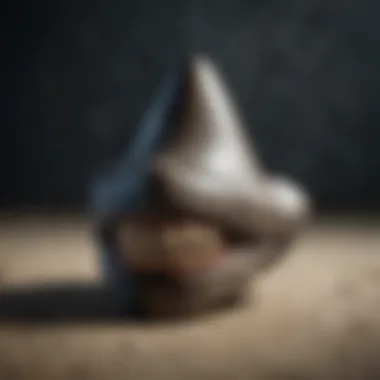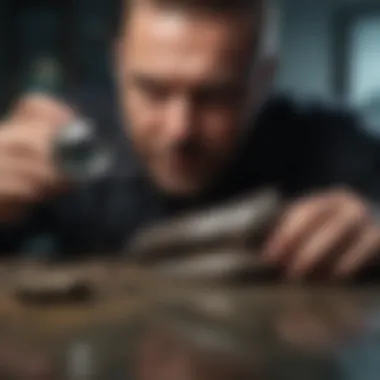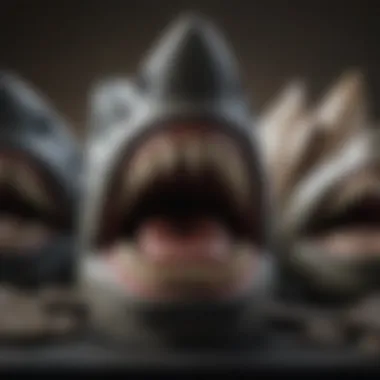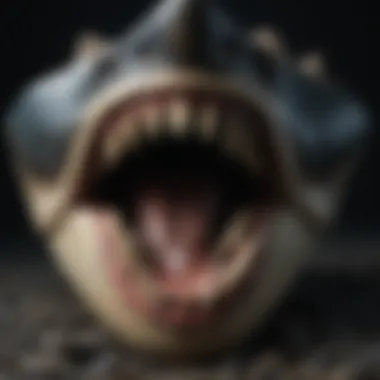Megalodon Teeth: A Comprehensive Guide for Collectors


Intro
The allure of megalodon teeth captivates collectors and enthusiasts alike. These fossils serve as tangible links to a prehistoric time when colossal sharks prowled the oceans. Imbued with historical significance and remarkable stories, megalodon teeth have garnered a place in many a collector’s display. Yet, navigating the market for these teeth requires more than just enthusiasm; a discerning eye and a head full of insights are essential.
In this article, we will explore various aspects of collecting megalodon teeth, from identification techniques to pricing nuances, alongside foundational knowledge about this ancient predator. Whether you're just dipping your toe into this fascinating realm or you're a seasoned collector looking to refine your expertise, you'll find valuable information here.
This guide aims to equip you with the skills and knowledge necessary to successfully engage with the market for megalodon teeth, all while enriching your appreciation for these magnificent, yet foreboding, remnants of the past.
Prologue to Megalodon Teeth
Megalodon teeth represent more than just a piece of ancient history; they are tangible links to a time when colossal predators roamed the world’s oceans. Understanding the significance of these fossils serves multiple purposes—it provides context for collectors and enthusiasts while also enhancing the appreciation for these remarkable creatures. As we dive deeper into this topic, readers will uncover the nuances that make megalodon teeth a fascinating, albeit intricate, collectible.
Understanding the Megalodon: An Overview
The megalodon is a species that draws in all sorts of imaginations and narratives, from documentaries to Hollywood films. Believed to have existed between 23 to 3.6 million years ago, it was the apex predator of its time, reaching lengths of up to 60 feet or more. Its name, derived from the Greek "mega" meaning large and "odous," meaning tooth, speaks volumes about its formidable dentition.
Megalodon teeth can measure over seven inches in length, showcasing a triangular form with serrated edges. These fossils are found all over the world, often unearthed along coastlines or riverbeds. This widespread presence contributes to their allure, as collectors from various backgrounds seek to possess these legendary remnants. The variety found—be it size, shape, or coloring—adds richness to the collecting experience. The teeth encapsulate more than just the megalodon’s biology; they reflect its environment, behavior, and, ultimately, its extinction.
The Appeal of Collecting Fossilized Teeth
The act of collecting megalodon teeth extends far beyond mere acquisition; it fosters connections to both natural history and personal narratives. For some collectors, these fossils are symbols of strength or power. Others are drawn in by the thrill of the hunt, whether scouring local beaches for washed-up treasures or navigating online marketplaces, ready to pounce on a rare find.
The stories behind individual teeth can also be compelling. Each piece may have a unique provenance that hints at its journey—perhaps it was excavated from ocean floors in the Carolinas or discovered in a fossil bed in Europe.
The collecting of these teeth operates on various emotional levels:
- Connection to History: Owning a piece of the past offers a profound sense of connection to an era long gone.
- Scientific Curiosity: For the scientifically inclined, megalodon teeth provide insights into the life and ecology of this prehistoric behemoth.
- Artistry in Nature: The natural aesthetics of these teeth captures the eye, making them a favored item for display in homes or personal collections.
In summary, whether someone is an avid paleontologist or a casual hobbyist, the allure of megalodon teeth is palpable and multi-faceted. This diverse appeal underscores the importance of understanding what these teeth represent in both a historical context and as sought-after collectibles.
The Geographic Landscape of Megalodon Teeth Sales
Understanding where to find megalodon teeth for sale is crucial for collectors. Different regions boast varied supplies and pricing structures, affecting what buyers can expect when they enter the market. This landscape helps potential collectors navigate local and international options effectively. A strong sense of geography gives buyers insight into availability and authenticity, ensuring that they make informed choices.
Local Market Dynamics
In many cases, the local market for megalodon teeth reflects the geological history of the area. Coastal regions, especially those with significant fossil beds, might yield more authentic finds than areas far removed from the ocean. Collectors often gather in places like South Carolina and Florida, where these teeth frequently wash ashore. Here, local fossil shops can become a haven for enthusiasts, offering a mix of genuine relics and friendly advice.
Local fossil shows and fairs also enhance the regional market. Vendors showcase their assorted wares, creating an opportunity for buyers to connect with others who share their passion. Such gatherings foster a sense of community among collectors. Knowledgeable sellers can provide insights regarding the provenance of their pieces, helping aspiring buyers gauge the authenticity of their potential investments.
"Buying local can often mean supporting a collector’s community and ensuring you're getting the real deal."
However, collectors should tread carefully with local purchases. Some sellers may not have fully vetted their items, leading to costly mistakes. It is vital for collectors to develop a keen eye and trust their instincts when evaluating potential purchases.
Online vs. In-Person Sales
In our digitally-driven age, online platforms have transformed how collectors access megalodon teeth. Websites such as eBay, Etsy, and specialized fossil retailers cater to a global audience, making rare specimens available at the click of a button. While browsing online can be enticing, it’s essential to remain vigilant about authenticity and conditions. Pictures may be deceiving, and the absence of an in-person inspection leaves room for disappointment.


Local markets provide tactile experiences—like holding a tooth before purchasing—which online sales cannot replicate. Handling the item allows for a better assessment of size, wear, and overall integrity. Many seasoned collectors prefer the traditional route, arguing that in-person sales often foster relationships that online transactions cannot.
Nevertheless, online marketplaces offer resources to help buyers make informed decisions. Customer reviews can guide potential collectors toward reputable sellers, while forums and groups on platforms like Reddit can provide invaluable tips and firsthand experiences.
When it comes down to it, the best strategy may be a hybrid approach. Combining both local and online sales can give collectors a comprehensive view of available options, enhancing their chances of finding that perfect megalodon tooth.
Identifying Authentic Megalodon Teeth
When diving into the world of megalodon tooth collecting, knowing how to spot authentic specimens is crucial. In a market teeming with forgeries, having a keen eye for detail can save collectors from costly mistakes. An authentic megalodon tooth is not just a fossil; it is a piece of ancient history, with stories etched in its enamel. Misidentifying these teeth can lead not just to financial loss, but also to missed opportunities in connecting with a fascinating past.
Therefore, understanding both the characteristics that signify genuine teeth and the common ways in which fraudsters attempt to sell fakes should be at the forefront of any collector's mind.
Key Characteristics to Look For
Recognizing an authentic megalodon tooth involves careful observation of its physical features. Here are some notable aspects to consider:
- Coloration: Authentic teeth display rich browns, grays, or even subtle greens. Bright or synthetic colors often suggest tampering or fake origins.
- Size and Shape: Adult megalodon teeth can reach over seven inches in length. Anomalies in size from established facts might be a red flag.
- Texture and Wear: A genuine tooth will exhibit natural wear patterns and fossils' unique textures. A brand-new, overly smooth tooth is suspicious.
- Root Structure: The root of a real megalodon tooth is more robust and has a characteristic triangular shape, often showing signs of erosion.
- Tip Condition: Authentic megalodon teeth often have worn tips, a sign of their long journey through geological time.
Pro Tip: Always compare suspected teeth to high-quality reference images online or in books. Familiarity can help one distinguish between a treasure and a trap.
Common Forgery Techniques
Knowing how deceit can show up in the fossil market is equally important. Forgeries can come in various forms, and some are quite sophisticated. Here are a few techniques used to clone megalodon teeth:
- Resin Replicas: These are often cast from authentic teeth and then painted to resemble natural colors.
- Artificial Aging: Some sellers treat new teeth to make them look older than they are, using chemicals to simulate wear or to darken the surface.
- Misleading Labels: Some forgers create fake provenance, claiming that a tooth comes from a specific, authenticated source when it does not.
- Tree Sap or Other Additives: A few forgers will coat fake teeth in resin or use tree sap to mimic real enamel, leading collectors astray.
When you're on the lookout for a megalodon tooth, an informed and cautious approach will go a long way. By recognizing these key characteristics and common forgery tactics, you'll be better prepared to navigate your purchasing journey with confidence.
Where to Find Megalodon Teeth for Sale
Finding megalodon teeth for sale is a fascinating endeavor that excites collectors and enthusiasts alike. These impressive fossils don’t just sit around waiting to be discovered; they can be found in various locations that range from local fossil shops to specialized online retailers. Understanding where to source these artifacts is vital for anyone looking to add to their collection or make an investment. Each avenue offers its own unique set of benefits and considerations, which can impact your purchasing decision and the overall satisfaction of your acquisition.
Local Fossil Shops and Museums
Visiting local fossil shops and museums can be a rewarding experience for collectors. These establishments often feature a selection of megalodon teeth and other fossils, displaying them as part of their educational missions. Local fossil shops tend to specialize in providing tangible insights into the natural history of our planet, making them invaluable resources.
Benefits of Shopping Locally:
- Hands-On Experience: One of the key advantages is the ability to physically examine the teeth. You can inspect size, color, and surface condition closely.
- Expert Guidance: Many shops employ knowledgeable staff who can offer insights into the teeth's authenticity and provenance. They can point you towards exceptional pieces or unique finds.
- Immediate Purchase: You can walk away with your prized find, avoiding the wait associated with shipping. Even better, it's a chance to support local businesses.
Still, some considerations should be kept in mind:
- Limited Selection: Depending on the area's popularity for fossil hunting, the inventory might be limited.
- Higher Prices: Local shops may charge a premium, especially if they offer unique specimens.
Specialized Online Retailers
In the age of the internet, specialized online retailers have emerged as significant players in the megalodon teeth market. Websites dedicated to fossils often have extensive inventories, featuring teeth collected from various locations around the world.


Advantages of Shopping Online:
- Wider Selection: Online retailers can provide access to rare and diverse options that might not be available locally. This is especially beneficial for collectors seeking specific sizes or conditions.
- Comparison Shopping: With just a few clicks, you can browse multiple sites to find the best prices or unique pieces that catch your eye.
- Detailed Descriptions: Many reputable online retailers include thorough descriptions, provenance details, and high-quality images, aiding buyers in making well-informed purchases.
However, online shopping does come with its own set of challenges:
- Verification of Authenticity: It's crucial to select reputable retailers. Many sites may sell replicas or forgeries if not careful.
- Shipping Risks: There can be risks involved with shipping valuable items, especially delicate fossils. If not packaged properly, damage can occur during transit.
"The excitement of discovering a megalodon tooth is only matched by the thrill of the hunt, whether in a store or online."
By weighing the pros and cons of local shops against the plethora of choices online, collectors have the opportunity to find megalodon teeth that truly resonate with them. Both pathways offer unique experiences and learning opportunities, enriching the journey of collecting these prehistoric treasures.
Pricing Factors for Megalodon Teeth
Understanding the pricing factors for megalodon teeth is crucial for anyone looking to enter this niche market. Collectors not only want to know how much to pay but also what justifies the price tag attached to these ancient relics. Several elements determine the worth of megalodon teeth, including size, condition, rarity, and even their backstory. Here, we will break down these factors in detail to offer buyers a better grasp on what they’re investing in.
Size and Condition of the Tooth
The size of a megalodon tooth can be a significant determinant of its price. Generally, larger teeth fetch higher prices, and this is understandable once you consider the appeal larger specimens hold for collectors. A tooth measuring over six inches can easily command thousands of dollars, while smaller ones might be priced more modestly. But it’s not just size that counts; condition matters as well.
Factors to note regarding condition include:
- Fossil Integrity: Teeth that are well-preserved without cracks or substantial wear are more coveted. Chips or fractures can greatly decrease value, even on a larger tooth.
- Coloration: Teeth with vibrant colors or unique patterns often attract collectors. Conversely, teeth that have faded or appear dull may not hold as much appeal.
- Desirability of Features: Unique features, like growth rings or distinctive shapes, can also raise the price.
To sum up, the interplay between size and condition can create a sliding scale of valuation. An unusually large and well-preserved tooth can be a real gem, while a smaller, poorly preserved specimen may struggle to fetch reasonable offers.
Rarity and Provenance
Another layer in the pricing puzzle is the rarity and provenance of a megalodon tooth. Collectors and enthusiasts often seek out teeth that are unique or come with a verified history. Rarity can stem from various factors such as geographical origin or the age of the tooth. For instance, a tooth from a less commonly found location or specific deposit might have a premium value attached.
When considering provenance, the narrative of the tooth can significantly influence its price. Factors that enhance the story include:
- Documented History: Teeth that come with a background—where and when they were discovered, or if they have been showcased in museums—tend to be valued higher.
- Previous Owners: If a tooth has a connection to a notable collector or researcher, its appeal—and thus its price—can greatly increase.
- Authenticity Certifications: Teeth with certificates from reputable sources can provide buyers with confidence, often leading to higher pricing.
"Knowing the story behind a megalodon tooth can sometimes be just as important as the tooth itself. Collectors value narratives like they value fossils."
Overall, navigating the realm of megalodon teeth pricing requires attention to these key factors. A balanced understanding of size, condition, rarity, and provenance can arm collectors with knowledge that leads to well-informed purchasing decisions.
Best Practices for Buying Megalodon Teeth
Navigating the market for megalodon teeth can feel like wandering through a jungle: filled with hidden paths, potential dangers, and treasures waiting to be discovered. To make this experience smoother, it’s vital to arm yourself with best practices that can help you make informed purchases. The essence of these practices revolves around ensuring you invest wisely and ethically while enjoying the thrill of collecting.
Establishing a Budget
Before you dive head-first into the world of megalodon teeth, it's important to take a moment and establish a budget. This step is crucial, as even small teeth can command hefty prices depending on their size, condition, and rarity. Paying attention to your financial boundaries not only protects your wallet but also brings clarity to your purchasing decisions.
- Know Your Range: Start by researching the average prices for megalodon teeth. Some teeth sell for hundreds, while others reach into the thousands. Understanding the range allows you to gauge what you can realistically afford.
- Account for Additional Costs: Don’t forget about shipping, potential taxes, or even any fees involved if you’re buying from auctions. All of these can quickly add to the bottom line, so factor them into your budget.
- Be Prepared for the Unexpected: Occasionally, you may come across a tooth that, while slightly outside your predetermined budget, might be too unique to pass up. Setting a flexible range can allow for such serendipitous finds without causing financial strain.


Evaluating Sellers
Now that you’ve set your budget, the next step is evaluating potential sellers. It's like trying to find Waldo in a crowded picture; you must sort through various options to identify sellers with genuine teeth and a trustworthy reputation.
- Research Seller History: Look for sellers with a proven track record. Online platforms like eBay or specific fossil websites often have seller ratings. Check reviews and customer feedback, as these are invaluable for assessing credibility.
- Ask Questions: Don’t be shy! For example, inquire about provenance or the process the seller uses to ensure authenticity. A reputable seller should feel comfortable discussing their knowledge and experience in the industry.
- Seek Expert Opinions: If you're uncertain, reach out to fossil community forums on platforms like Reddit. Experts and enthusiasts often frequent these places and can share their insights or recommend trusted sellers.
Remember: The authenticity and quality of the teeth are paramount. It’s better to delay a purchase than rush and regret it later.
- Compare Prices: Ensure you take your time to compare prices among different sellers. Sometimes, a tooth that looks identical may be offered at varying prices. This not only provides peace of mind but also ensures you're getting the best deal within your budget.
By adhering to these best practices, you’ll not only minimize potential risks but also enhance your overall collecting experience, making it a fulfilling endeavor.
Care and Preservation of Megalodon Teeth
Caring for and preserving megalodon teeth is crucial for collectors who wish to maintain their value and beauty over time. These fossils serve not only as remarkable conversation pieces but also as links to a prehistoric world that captivates the imagination. When managed properly, they can stand the test of time while depicting the history of the giant fish that once ruled the oceans. Let’s dive into some key aspects of caring for these irreplaceable treasures.
Cleaning and Maintenance Techniques
Keeping megalodon teeth clean is essential for preserving their integrity and appearance. Here are some practical steps and techniques that collectors can use:
- Gentle Cleaning: Use a soft brush, like a toothbrush, to remove dirt and debris from the tooth’s surface. Be careful here; you don’t want to wear down any delicate areas.
- Mild Soap Solution: For stubborn dirt, mix a few drops of dish soap with warm water. Dip a cloth in the solution, wring it out well, and gently wipe the tooth. Rinse with clean water and dry immediately with a soft towel.
- Avoid Harsh Chemicals: Never use bleach or strong solvents, as these can damage the tooth's surface and finish.
- Wax Coating: Applying a thin layer of microcrystalline wax can enhance the tooth's luster while also providing a protective layer against dust and moisture. Be sure to repeat this step every few years to maintain the shine.
"Cleaning is not just a chore; it's a way to connect with history. Each brush stroke is a gentle reminder of the depth of time these pieces represent."
By engaging in these simple, yet effective maintenance techniques, collectors can ensure that their megalodon teeth look great and stay robust for years to come.
Display and Storage Solutions
When it comes to displaying and storing megalodon teeth, the objective is to strike a balance between visibility and protection. Here are some strategies to consider:
- Display Cases: Invest in a quality display case made of acrylic or glass to protect against dust and scratches while allowing for visibility. Ensure the case is UV resistant to protect against sunlight, as prolonged exposure can lead to deterioration.
- Shelving Units: If you prefer an open display, use sturdy shelving that can securely hold larger pieces. Keep teeth away from the edge to prevent them from accidentally being knocked off.
- Humidity Control: Ensure that your display or storage area has low humidity levels. Too much moisture can lead to mineral changes and degradation, causing the teeth to lose their valuable qualities.
- Temperature Stability: Store megalodon teeth in a climate-controlled room. Extreme temperatures can lead to crack and discoloration over time.
- Avoid Overcrowding: When storing teeth, avoid packing them too closely together. This ensures that they are shielded from accidental scratches or damage caused by movement.
Collectively, these methods enhance not just the aesthetic appeal of megalodon teeth but also help the collector appreciate their historical significance. Caring for these fossils is about respect for their fascinating past, which extends beyond just being mere collectibles.
The Ecological and Historical Significance of Megalodon Teeth
Megalodon teeth are not just fascinating artifacts; they hold immense value from both ecological and historical perspectives. Collectors often appreciate these teeth not only for their size and rarity but also for the story they tell about life millions of years ago. Understanding the ecological and historical significance of these fossils can deepen a collector's appreciation and inform a more nuanced collection philosophy.
Megalodon's Role in the Ecosystem
When megalodon swam in our oceans, it was at the top of the food chain. This ancient predator played a crucial role in maintaining balance within marine ecosystems.
- Predatory Dynamics: As a formidable predator, megalodon regulated populations of its prey, which included large marine mammals and fish. By doing so, it ensured that no single species became too dominant, thus promoting biodiversity.
- Ecological Indicators: The presence of megalodon teeth in sediment layers today can serve as indicators of ecological health in ancient times. The size, distribution, and condition of these teeth can reveal valuable information about the environment where these sharks thrived.
- Evolutionary Insights: Studying megalodon teeth aids in understanding evolutionary pathways of not just sharks, but entire marine ecosystems. These teeth, often found in various geological layers, act as time capsules that provide insights into how sea life has adapted—or failed to adapt—throughout epochs.
Megalodon is long extinct, but it left behind a legacy that impacts our understanding of evolutionary biology and ecology. Collectors who study these teeth contribute to ongoing conversations regarding marine conservation and the importance of apex predators.
Cultural Impact Throughout History
The fascination with megalodon teeth extends far beyond mere scientific interest. Throughout history, these fossils have influenced culture in various ways, emerging as symbols laden with meaning.
- Myth and Legend: In many coastal societies, giant shark teeth have been regarded as talismans or components of mythological narratives. They symbolize power, strength, and the mysterious depths of the ocean. Their size and ferocity have inspired tales of formidable sea creatures that roam our waters.
- Art and Decoration: Across different cultures, megalodon teeth have been used in art. From necklaces to ornate dagger handles, their physicality and striking appearance made them excellent materials for craftsmanship. The act of adorning oneself with these fossils speaks to humanity's connection with nature and the desire to embody the essence of a great predator.
- Scientific Value: In contemporary culture, megalodon teeth are often used in educational contexts. Museums and academic institutions utilize them to illustrate discussions about ancient marine life, the prehistory of sharks, and how environmental changes alter ecosystems over time. They play an essential role in engaging the public with science, inspiring future generations of paleontologists and marine biologists alike.
Megalodon teeth encompass a rich tapestry of stories—biological, ecological, and cultural. These narratives can deepen a collector's understanding of their significance beyond mere aesthetics or monetary value. Whether displayed in a personal collection or showcased in public venues, megalodon teeth bridge the past and present, enriching our collective knowledge and cultural heritage.



